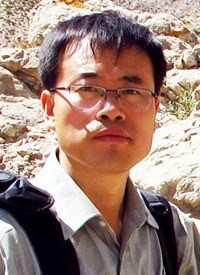Paleontology Working Group
OneFossil is a multi-dimensional scientific database of fossil specimens for virtual examination and data-driven stratigraphical and paleontological research. This is the contribution to the Paleontology Working Group of the DDE.
Leaders:

Dr. Sylvie Crasquin,
President of the International Palaeontological Association (IPA)
Centre de Recherche en Paléontologie, Sorbonne Université.
Paris, France.
E-Mail: sylvie.crasquin@mnhn.fr
Working area:
Micropaleontologist, specialist of marine ostracods (Crustacea) from Carboniferous to Triassic. Systematic, Paleoecology, Paleoenvironnement reconstructions, Paleobiogeography, Dynamic of biodiversity during crisis events: Late-Palaeozoic – Early Mesozoic.

Dr. Jun Wang, Prof.
Nanjing Institute of Geology and Palaeontology, Chinese Academy of Sciences.
Nanjing, China.
E-Mail: jun.wang@nigpas.ac.cn
Working area:
Carboniferous and Permian floras and their ecosystem. Current research projects include: 1) A systematic study on Noeggerathialeas—A group of Palaeozoic plants with uncertain affinity, most poorly known Palaeozoic plant group.
2) A restoration of an early Permian peat-forming vegetation preserved in ash-fall tuff in Inner Mongolia. The tuff flora is an exceptionally well-preserved window to the palaeo-ecosystem of so-called Cathaysian Realm.
3) The evolution of Carboniferous and Permian floras under the background of Icehouse and Greenhouse transition. Carboniferous and Permian may be the only geo-historical time when the earth had well-developed vegetation and went through Icehouse and Greenhouse climatic changes. The principle of vegetational response to Icehouse-Greenhouse transition during Palaeozoic could be meaningful for understanding the vegetational change in response to the present Icehouse-Greenhouse transition.
Secretary-general:

Dr. Honghe Xu. Prof.
Nanjing Institute of Geology and Palaeontology, Chinese Academy of Sciences.
Nanjing, China.
E-Mail: hhxu@nigpas.ac.cn
Working area:
1) Biodiversity and evolution of early land plants and their paleoenvironment background. Fossil plant systematics, taxonomy, paleophytogeography and evolutionary botany; and growth model of the earliest forest-forming plants. 2) Quantitative and systematical study and artificial intelligence of paleontology and stratigraphy. The related study includes analyzing and mining big data of paleontology and stratigraphy to discover potential knowledge; powering Geobiodiversity database, fossil images database and their websites (geobiodiversity.com and fossil-ontology.com); understanding the ontology of ancient organisms in the geological ages.
Data Manager:

Mr. Yansen Chen,
Nanjing Institute of Geology and Palaeontology, Chinese Academy of Sciences.
Nanjing, China.
E-mail:yschen@nigpas.ac.cn
Working Area:
Engineer. Designing, development, operation, and maintenance of the Geobiodiversity Database (GBDB) and Fossil-Ontology websites, Data processing.